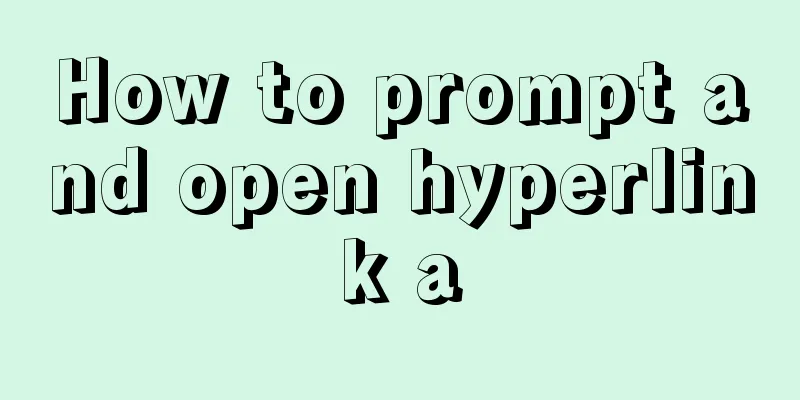Let’s talk in detail about how browsers view closures

PrefaceClosures are a major difficulty in understanding JavaScript. There are many articles about closures on the Internet, but there are few articles that can make people fully understand them after reading them. The reason, I think, is that closure involves a series of knowledge points. Only by thoroughly understanding this series of knowledge points and achieving a closed loop of a concept can you truly understand it. Today I plan to understand closures from a different perspective, from the perspective of memory allocation and recycling, hoping to help you truly digest the closure knowledge you have seen. At the same time, I also hope that this article will be the last article you read about closures. When you look at the pictures in this article, please keep in mind the direction of the arrows. Because it is the principle that the root object window relies on to traverse memory garbage, anything that can be found along the arrow starting from the window is not memory garbage and will not be recycled. Only those objects that cannot be found are memory garbage and will be recycled by GC at the appropriate time. Introduction to ClosuresWhen functions are nested, the inner function references the variables in the outer function scope, and the inner function is referenced by the variables in the global environment, thus forming a closure.
One thing we need to pay special attention to about closures is that all functions defined inside a function share the same closure object. What does it mean? Look at the following code:
var a
function b() {
var c = new String('1')
var d = new String('2')
function e() {
console.log(c)
}
function f() {
console.log(d)
}
return f
}
a = b()In the above code, f references the variable d, and f is referenced by the external variable a, so a closure is formed, causing the variable d to remain in the memory. Let's think about it, what about variable c? It seems that we didn't use c, so it shouldn't stay in the memory. Then there is the fact that c will also linger in memory. The closure formed by the above code contains two members, c and d. This phenomenon is called intra-function closure sharing. Why do we need to pay special attention to this feature? Because of this feature, it is easy to write code that causes memory leaks if we are not careful.
You can search these contents on Google or Baidu to get a general understanding. Next I will talk about how to understand closures from the browser's perspective, so I won't explain it in detail. How to identify memory garbageThe garbage collection process of modern browsers is relatively complicated. You can google the detailed process yourself. Here I will only talk about how to determine memory garbage. Generally speaking, it can be understood that starting from the root object, anything that can be found by following the reference cannot be recycled. Objects that cannot be found by following the reference are considered garbage and are recycled at the next garbage collection node. Looking for garbage can be understood as a process of following the clues. Memory representation of closuresStarting with the simplest code, let's look at the global variable definition.
var a = new String('小歌')Such a piece of code is represented in memory as follows
In the global environment, a variable a is defined and a string is assigned to it. The arrow indicates a reference. Let's define another function:
var a = new String('小歌')
function teach() {
var b = new String('小谷')
}The memory structure is as follows:
Everything is easy to understand. If you are careful, you will find that there is an attribute called [[scopes]] in the function object teach. What is this? Why does this attribute appear after the function is created? I'm glad you asked this, it's a key point to understand closures. Please remember: Once a function is created, the JavaScript engine will attach a property called scope chain to the function object. This property points to an array object that contains the function's scope and parent scope, all the way to the global scope. So the above figure can be simply understood as: the teach function is created in the global environment, so the scope chain of teach has only one layer, that is, the global scope global
Please remember again: When a function is executed, space is requested to create an execution context. The execution context includes the scope chain when the function is defined, and secondly includes the variables and parameters defined inside the function. When the function is executed in the current scope, it will first search for variables under the current scope. If it cannot be found, it will search in the scope chain when the function is defined until it reaches the global scope. If the variable cannot be found in the global scope, an error will be thrown. We all know that when a function is executed, an execution context is created, which is actually applying for a memory space of a stack structure. The local variables in the function are allocated in this space. After the function is executed, the local variables are recycled at the next garbage collection node. OK, let's update the code again and take a look at the memory structure when the function is running.
var a = new String('小歌')
function teach() {
var b = new String('小谷')
}
teach()The memory is represented as follows:
Obviously, we can see that the function only assigns a local variable during execution and has no relationship with the variables in the global environment. Therefore, if we search from the window object along the reference (arrow in the figure), we cannot find the variable b in the execution context. Therefore, after the function is executed, the variable b will be recycled. Let's update the code again:
var a = new String('小歌')
function teach() {
var b = new String('小谷')
var say = function() {
console.log(b)
}
a = say
}
teach()The memory is represented as follows:
Note: Gray indicates objects that cannot be tracked from the root object. Function execution order:
After the function is executed, variable b should be released under normal circumstances. However, we find that we can find b by searching along the window. According to the principle of determining memory garbage we mentioned earlier, b is not memory garbage, so b cannot be released. This is why closures keep variables within functions in memory. Upgrading the code again, let's look at the memory representation shared by the closure:
var a = new String('0')
function b() {
var c = new String('1')
var d = new String('2')
function e() {
console.log(c)
}
function f() {
console.log(d)
}
return f
}
a = b()
The gray graphics are memory garbage and will be recycled by the garbage collector. It is easy to see from the above figure that although function f does not use variable c, c is referenced by function e, so variable c exists in the closure closure. Variable c can be found by starting from the window object, so variable c cannot be released. You may ask, how can this feature lead to memory leaks? Well, consider the following code, a classic meteor memory leak problem.
var t = null;
var replaceThing = function() {
var o = t
var unused = function() {
if (o)
console.log("hi")
}
t = {
longStr: new Array(1000000).join('*'),
someMethod: function() {
console.log(1)
}
}
}
setInterval(replaceThing, 1000)This code has a memory leak. If you execute this code in the browser, you will find that the memory keeps rising. Although GC releases some memory, there is still some memory that cannot be released, and it rises in a gradient. As shown below
This curve indicates that there is a memory leak. We can use developer tools to analyze which objects have not been recycled. In fact, I can tell you that the memory that is not released is actually the large object t we create each time. Let’s take a look at this by drawing a picture:
The above picture assumes that the replaceThing function is executed three times. You will find that each time we assign a large object to the variable t, due to closure sharing, the previous large object can still be tracked from the window object, so these large objects cannot be recycled. In fact, what is really useful to us is the large object assigned to t last time, so the previous object caused a memory leak.
The solution to this problem is also very simple. Each time the code is executed, set the variable o to null. You can try it. ConclusionThis is the end of this article about how browsers view closures. For more information about how browsers view closures, please search for previous articles on 123WORDPRESS.COM or continue to browse the following related articles. I hope you will support 123WORDPRESS.COM in the future! You may also be interested in:
|
<<: Detailed explanation of iframe tag usage (attributes, transparency, adaptive height)
>>: Detailed process of using nginx to build a webdav file server in Ubuntu
Recommend
Teach you how to enable the Linux subsystem of Win10 (with detailed pictures and text)
Today I will introduce how to enable the Linux su...
Implementation steps of js object-oriented encapsulation cascading drop-down menu list
The cascading drop-down menu developed in this ex...
Summary of common problems and solutions in Vue (recommended)
There are some issues that are not limited to Vue...
Detailed explanation of MySQL semi-synchronization
Table of contents Preface MySQL master-slave repl...
How to implement a single file component in JS
Table of contents Overview Single file components...
Tutorial on installing MySQL 5.6 on CentOS 6.5
1. Download the RPM package corresponding to Linu...
Solve the mobile terminal jump problem (CSS transition, target pseudo-class)
Preface Many friends who have just come into cont...
Optimizing the slow query of MySQL aggregate statistics data
Written in front When we operate the database in ...
Keepalived implements Nginx load balancing and high availability sample code
Chapter 1: Introduction to keepalived The purpose...
js canvas realizes slider verification
This article example shares the specific code of ...
Docker image analysis tool dive principle analysis
Today I recommend such an open source tool for ex...
Markup validation for doctype
But recently I found that using this method will c...
How to add rounded borders to div elements
As shown below: CSS CodeCopy content to clipboard...
JavaScript flow control (loop)
Table of contents 1. for loop 2. Double for loop ...
Share 20 excellent web form design cases
Sophie Hardach Clyde Quay Wharf 37 East Soapbox Rx...
















